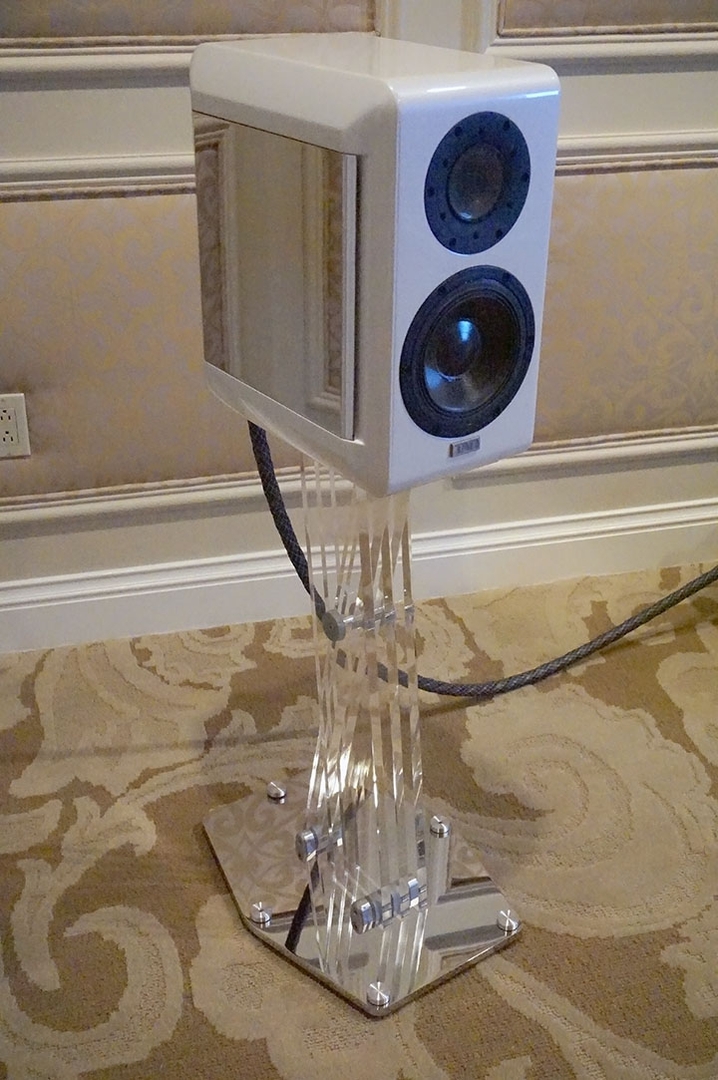
One of my assigned product coverage categories for CES is a traditional favourite of mine and of many Hi-Fi+ readers; namely, sensibly priced loudspeakers priced at $25,000/pair and below. As you will see below, there are many sonic gems in this category, spanning a wide range of price points.
What of even higher-priced loudspeakers? Well, Editor Alan Sircom (the lucky fellow) gets to cover those, proving once again that it is indeed good to be ‘King’.
Rather than offer the proverbial ‘laundry list’ of all the speakers I saw and heard at CES, I’ve tried to single out just ten new models that caught my eyes and ears, and that I believe many of you will find rewarding to learn about and—eventually—to audition for yourselves. I offer my apologies in advance to the many worthy manufacturers whose loudspeaker I have left out of this blog. Please know, then, that this is purely an attempt to capture some (but not all) noteworthy highlights from CES and to share insights about some speakers that put a big smile on my face at the show.
Crystal Minissimo Diamond monitor €16,000, & Subissimo subwoofer, $10,000
Hi-Fi+ Editor Alan Sircom has favourably reviewed the original Crystal Minissimo monitors and now Crystal has gone and improved the breed with an updated and performance enhanced Minissimo Diamond model. The new version, which on cursory inspection appears similar to the old, differs in that it uses a diamond tweeter fitted with a voice coil whose coil windings and run-out leads both use silver conductors, with 6dB/octave crossover slopes, and internal cabinet volume pushed up form 4.5 to 5 litres. As before, stands are included for the Minissimo Diamonds. The result is a good thing made even better—a highly capable and truly lovely looking standmount monitor.
However, to really hear the Minissimo Diamond be all that it can, the monitors should be heard in conjunction with Crystal’s elegant new Subissimo subwoofer. The Minissimo Diamond/Subissimo sub combination is one of those sonic matches ‘made in heaven’, where the whole is greater than the sum of the already excellent parts. Oh, and did we mention the Subissimo makes a perfect ‘stand’ for Crystal’s CSI integrated amplifier, should you choose to use one? It does, as shown in the photo here.
ELAC Uni-Fi UB5 monitors, $500/pair
ELAC designer Andrew Jones has been on a roll of late, where the name of the game is to create well and truly affordable loudspeaker products that offer what ELAC competitors are sure to regard as embarrassingly high levels of performance. A perfect case in point would be Jones’ new ELAC Uni-Fi UB5 bookshelf monitors, which feature a concentric tweeter/midrange array (1-inch tweeter at the centre of a 4-inch midrange driver), plus a 5.25-inch bass driver. The three-way monitors are, to put it bluntly, ridiculously affordable given the sheer levels of technology and performance on offer. Show-goers left the ELAC demonstration room shaking their heads in disbelief because the little UB5’s sounded so good that, in all honesty, ELAC could probably have tacked an extra zero on the end of the speaker’s price tag and no one would have batted and eyelash. Value—and plenty of it—spoken here.
GoldenEar Technology Triton Two+ and Three+, respectively $2,500/pair and $3,500/pair
When I reviewed GoldenEar’s to-of-the-range Triton One floorstanding loudspeaker for Hi-Fi+, my sense was that the speaker represented a ‘sea change’ of sorts—a dramatic step up in overall performance relative to the firm’s already very good product range as released up to that point. Apparently, GoldenEar felt much the same way, so that for CES it introduced revised version of two of its top-tier Triton models, with an eye toward bringing their overall performance and sound much more in line with the critically acclaimed Triton One.
As result, we now have the Triton Three+ ($2,500/pair) and Triton Two+ ($3,500), both of which have received massive infusions of Triton One-inspired design know-how and voicing. So, in a nutshell, what make the ‘+’ models a plus for consumer is that they can now stand shoulder-to-shoulder with their bigger brother, offering levels of refinement and overall resolution that are now comparable to their illustrious sibling. To accomplish these goals, the Triton Three and Two were treated new mid-bass drivers, new crossovers (balanced types, as in the Triton One), new polypropylene capacitors, new bass tuning, and—most importantly—Triton One voicing. If you’ve yearned for Triton Ones, but couldn’t quite swing the price, GoldenEar has now given you a big taste of Triton One-like performance in its new Triton “+” series models.
Kii Three self-powered monitors, $13,900/pair
Most audiophiles recognize the great Belgian designer Bruno Putzeys as the creator of both the Philips Hypex UCD (universal Class D) and the NCORE Class D audio amplifier modules, and as the guiding founder of Mola-Mola electronics. But for CES, Putzeys revealed himself in an entirely new role: namely, that of a very high-tech, high-end loudspeaker designer.
Let me come right out and say it; Bruno Putzeys first effort in the loudspeaker category, known as the Kii Three monitor, category is a stunning success and one that is surprisingly reasonably priced given the levels of performance and technology on offer. The Kii Three is a 3-way, six-driver, self-powered monitor speaker that provides both an analogue and digital input. The speaker incorporates a front firing tweeter and midrange driver, two side-firing woofers, and two rear-firing woofers. Each driver is powered by (what else?) its own NCORE amplifier module operating under the control of driver-specific DACs that help provide crossover functions, plus what Kii terms “Active Wave Focusing’ filter functions said to retain “full time alignment all around the speaker” whilst minimising the influence of the walls behind the speaker to a point where “the rear wall has no impact.”
These compact monitors produced a big, taut, full-bodied sound that was very well balanced, detailed and transparent, and full of dynamic life. Based on my initial listening, hope is that Hi-Fi+ will have a chance to review this exciting new design in the year to come
MartinLogan Renaissance ESL 15A, $25,000/pair
Last year MartinLogan rolled out an impressive new flagship hybrid electrostatic speaker called the Neolith, priced at about $80,000/pair. The trouble with flagship loudspeakers, though, is that despite their admittedly soul-stirring performance and striking good looks (both of which the Neolith has in spades), they tend to be either too large and/or too expensive for any but an elite few to own and enjoy.
To address this issue, while still preserving the essence of the core design concepts behind the Neolith, MartinLogan introduced at CES a new very high-performance hybrid electrostatic loudspeaker called the Renaissance ESL 15A. The speaker is large (but not nearly as big as the Neolith) and expensive (but less than one third the price of the Neolith) and so stands as what I would consider to be a real-world flagship for the rest of us (well, those of us who have a spare $25,000 waiting to be well-spent). The Renaissance spots a 46-inch and 15-inch midrange/high-frequency panel, married to a self-powered, dual 12-inch woofer system driven by a pair of 500-watt woofer amplifiers. To ensure proper matching between the dynamic woofers and the electrostatic panel, the speaker uses a Vojtko crossover and ML’s signature ‘ForceForward’ woofer alignment. Adding further refinement and tuning capabilities, the woofer also features a woofer-optimised version of the Anthem Room Correction system, meaning the built-in sub can in large part adapt to your environment as needed.
A too brief listen convinced me the Renaissance ESL 15A is an awful lot of speaker for the money: highly refined and, like the Neolith, exceedingly transparent.
Nola Brio Trio, $2,700/three-piece system
Nola design chief Carl Marchisotto is perhaps best know for his costly and physically imposing tower-type loudspeakers, but a passion of his has long been to bring the famous Nola sound to a much wider audience through a compact, scaled-back (but pointedly not scaled ‘down’), and accessibly-priced speaker system. That system turn out to be the new three-piece, satellite/subwoofer Brio Trio system, which consists of a pair of 5.5-inch x 5.5-inch x 12-inch, 1 ½ -way, quasi-dipolar satellite speakers and a matching Brio subwoofer with an 8-inch woofer, a sealed enclosure, and a 250-watt Class A/B (not Class D) amplifier. The result is very simple and affordable three-piece system that, in due Nola fashion, sounds much more muscular, expansive, and musically evocative than it has any right to do for its size or price.
Scansonic MB-6, $9,900/pair
Many audiophiles think of Michael Borresen as the talented designer of Raidho’s upscale, world-class loudspeakers, but what they may not realise is that Borresen has recently been doing some of his best work in creating speakers for Raidho’s sister company, Scansonic. In fact, Borresen has designed a Scansonic range that bears his initials, a new flagship for which—called the MB-6—was introduced at CES. The MB-6 is a comparatively tall, slender floorstander fitted with a central ribbon tweeter flanked by two sets of three 4.5-inch carbon fibre mid-bass drivers. The pair of drivers immediately adjacent to the tweeter handles midrange frequencies only, while the drivers further out from the tweeter handle progressively lower frequencies. Together, the six mid-bass drivers have the area of a 12-in woofer, but the speed and agility of much smaller drivers. The MB-6’s will sell for $9,900/pair in the process giving a significant taste of Raidho-like sound at a more than fair price.
Sonus faber Venere S, $4,999-$5,499/pair
The Venere range of speakers could be considered, along with the firm’s Chameleon range, as Sonus faber’s entry-level models, but at the very top of the Venere family tree stands one model, the Venere S (or Venere Signature), that stands apart from the firm’s other ‘V’ models. For starters, if my information is correct, the Venere S is the only Venere model that is produced in Italy, with all the attention to fit, finish, and design that Italian craftsmanship can bring to bear. Moreover, though, the Venere S deliberately straddles a performance line between the already very good Venere models and the even better (but also markedly more expensive) Olympica models.
The result is a strikingly beautiful 3-way, five-driver, floorstanding loudspeaker fitted with a 29mm DKM dome tweeter, a 150mm midrange driver fitted with a thermo-moulded polypropylene/textile cone, and three 180mm aluminium-coned woofers. At first glance, the speaker appears to be a sealed enclosure design, but as it turns out the built in floor plinth/riser stand neatly conceal a downward firing, aluminium ducted port.
Sonically, the Venere S is every inch a ‘real’ Sonus faber, exuding the suave, sophisticated, and oh-so-accessible musicality for which the brand is famous. Upon first encountering the Venere S, everything about its appearance and sound might lead you to expect a high four-figure or low five-figure price tag, so learning the actual price comes as a present surprise indeed. There is an awful lot of speaker here for the money, and—if you decide to acquire a pair—there’s absolutely no need to tell your audio buddies how little you actually spent.
Spendor SP200, $25,000/pair
Las Vegas loves big spenders, but for audiophiles attending CES a key attraction was a different kind of Big Spendor in the form of the British firm’s new SP200 floorstanding loudspeaker, which takes its place atop Spendor’s Classic range and will sell for $24,995/pair. The SP200’s driver array consists of a pair of 30cm bextrene-coned woofers (similar in concept to those used in Spendor’s BC3 Broadcast reference monitors) in a sealed enclosure, an 18cm EP77 polymer-coned midrange driver, and a 22mm wide surround polyamide dome tweeter. The cabinets, in turn, used construction methods and thin, lightly braced, visco-elastically dampened panels that hark back to classic Spendor models of old (think of the legendary BC-1 monitors, for example), but in an updated form. The cherry woodwork, by the way, is exquisite. The result, to my ears at least, is a loudspeaker that sounds at once highly capable and revealing, yet that perfectly captures that elusive quality of all-purpose musicality. If the time pressure of the show had not been upon me, I could have listened to the SP200’s for hours.
TAD White Carat concept monitor, ~ $12,000 – $15,000
Not unlike automakers who bring ‘concept cars’ to shows as a means of gauging reactions among potential customers, TAD decided to bring an important new ‘concept speaker’ to CES—a speaker known, for now, as the White Carat. A company spokesman told me that, brought to full production status, the White Carat would likely sell in the range of $12,000 – $15,000/pair, which would place it well under the price of the TAD Compact Evolution 1 monitors reviewed in Hi-Fi+ issue 129.
In fact, upon closer inspection, the White Carat could in some respects be considered a take on the Compact Evolution 1, but in a smaller and less costly format. Like the Compact Evolution 1, the heart of the White Carat is a coincident tweeter/midrange driver array, but with a twist: the White Carat uses a hybrid magnesium/beryllium driver array rather than TAD’s traditional all-beryllium array. In the cast of the Carat, the midrange driver diaphragm is magnesium, while the tweeter diaphragm is beryllium.
Honestly, hybrid mixes of driver materials don’t always turn out well, but in the case of the White Carat the hybrid mix works out spectacularly well—judging by the proof-of-concept prototypes on display. The result is a speaker that retains most if not all of the transparency of the Compact Evolution 1, but that introduces a very subtle (and very musical) touch of natural acoustic warmth that, if anything, makes the White Carat an even more inviting and engaging speaker than its bigger brother—at least for general purpose, day-in/day-out listening. The White Carat is no ‘diamond in the rough’, either; instead, to my ears, it seemed a more or less production-ready diamond that exuded equal parts brilliance and gracious musical refinement.
Tags: FEATURED
By Chris Martens
More articles from this authorRead Next From Show
See all
Bristol Hi-Fi Show 2024
- Feb 29, 2024

UK Audio Show 2023: Daventry
- Dec 13, 2023

AXPONA 2023 overview and highlights
- Apr 18, 2023

KEF at Audio Show Deluxe
- Apr 17, 2023




















